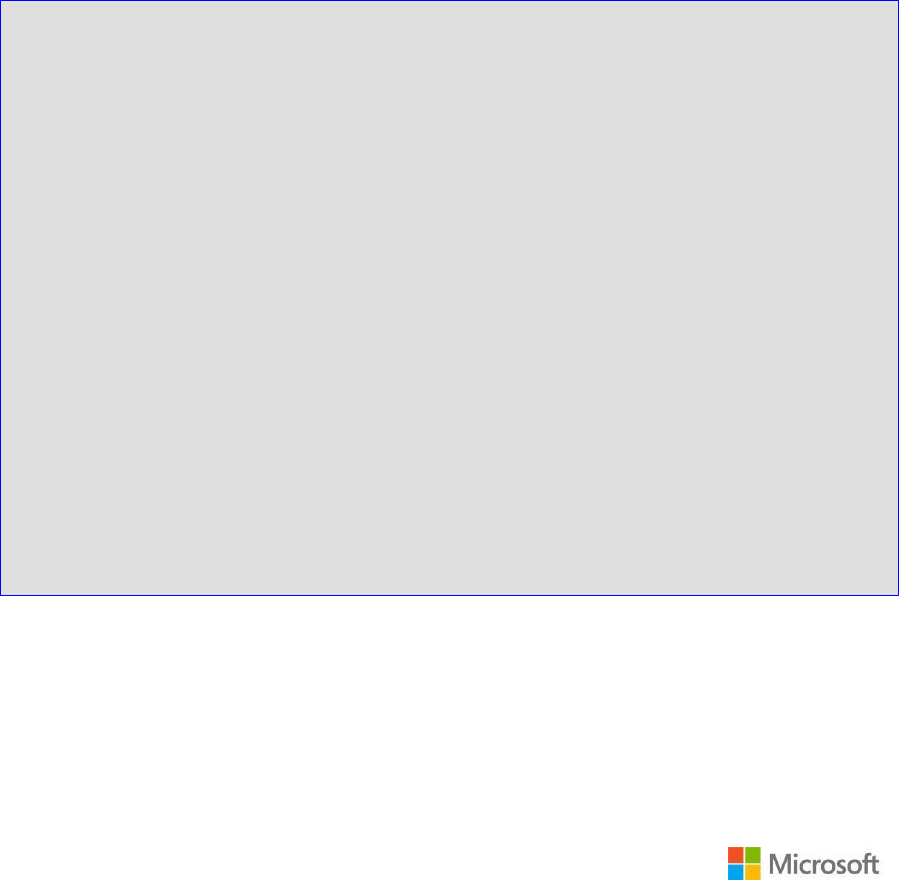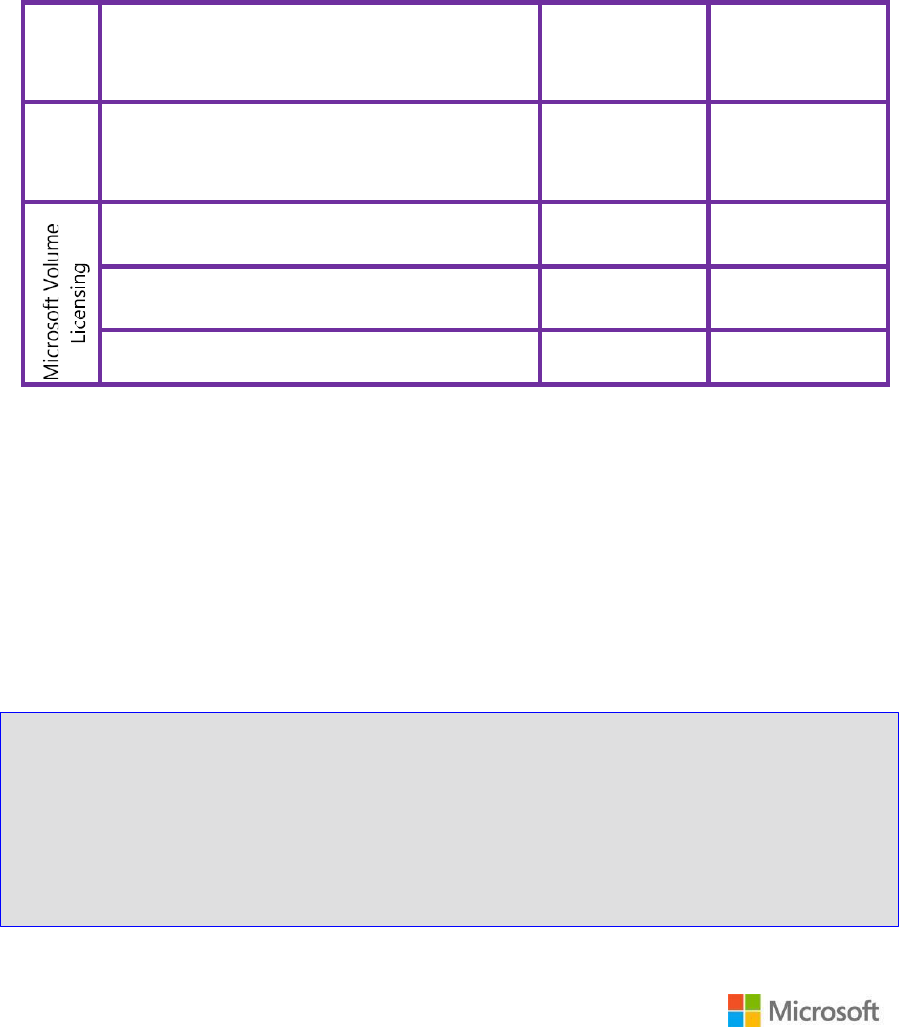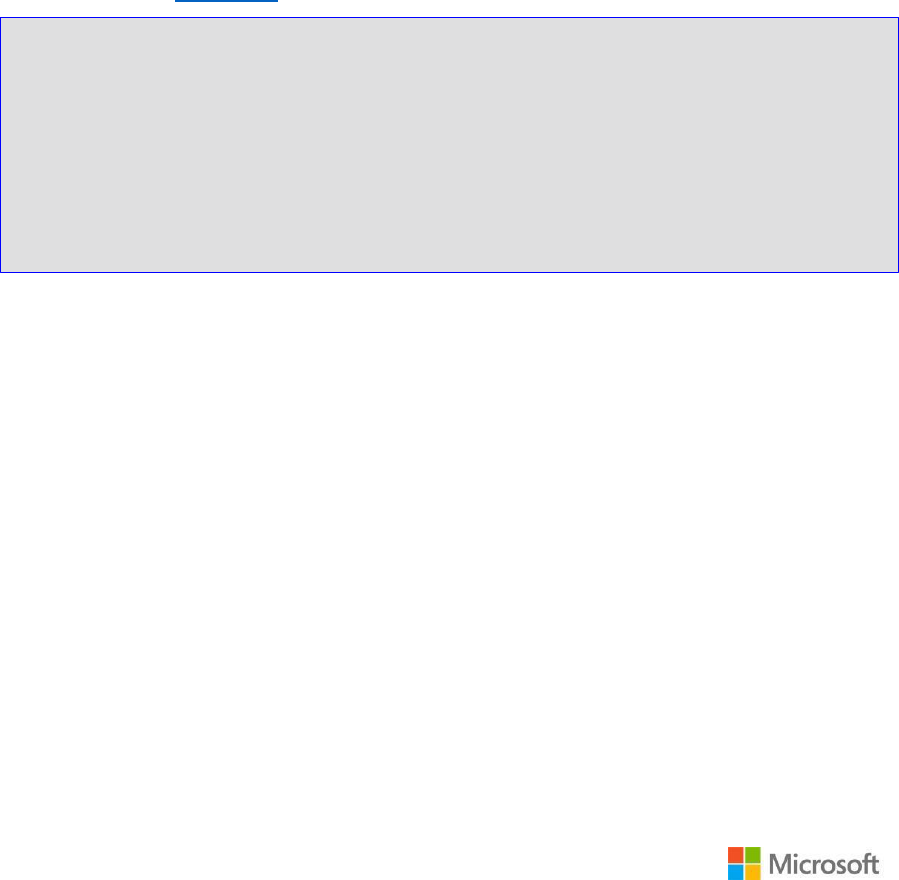
Licensing Whitepaper for the Microsoft
Visual Studio Product Family and Visual
Studio Subscriptions
Published June 2023
© 2023 Microsoft Corporation. All rights reserved. This document is provided "as-is." Information and
views expressed in this document, including URL and other Internet Web site references, may change
without notice. You bear the risk of using it.
This document does not provide you with any legal rights to any intellectual property in any Microsoft
product.
You may copy and use this document for your internal reference.

2
© 2023 Microsoft Corporation. All rights reserved.
Contents
Introduction ............................................................................................................................................................................................ 5
Visual Studio 2022 Licensing Overview ........................................................................................................................................ 5
Users .......................................................................................................................................................................................................... 5
The Azure DevOps Server Environment ....................................................................................................................................... 5
Azure DevOps ........................................................................................................................................................................................ 6
How to Buy .............................................................................................................................................................................................. 7
Visual Studio 2022 Offerings and Purchasing Channels ....................................................................................................... 7
Visual Studio Community .................................................................................................................................................................. 7
Who can use the Software ................................................................................................................................................................ 7
Visual Studio Build Tools.................................................................................................................................................................... 8
Visual Studio Subscription Renewals and Upgrades .............................................................................................................. 9
Standard Subscriptions ....................................................................................................................................................................... 9
Standard Subscription Upgrade Options .................................................................................................................................. 10
Renewing Down .................................................................................................................................................................................. 10
Cloud Subscriptions ........................................................................................................................................................................... 11
Azure DevOps Purchasing ............................................................................................................................................................... 11
Other Channels .................................................................................................................................................................................... 11
User Licensing ...................................................................................................................................................................................... 12
What Software is Included and Downgrade Rights .............................................................................................................. 12
Different Licensed Users Can Run the Same Software ......................................................................................................... 12
Where the Software can be Installed and Run ........................................................................................................................ 13
Additional Use Rights and Benefits for Visual Studio Subscribers .................................................................................. 14
Microsoft 365 E5 ................................................................................................................................................................................. 14
Production Use of Azure DevOps Server ................................................................................................................................... 14
Monthly Azure Credits for Visual Studio Subscribers ........................................................................................................... 14
Azure DevOps Benefits for Visual Studio Subscribers .......................................................................................................... 14
Cloud Use Rights: Running the Subscriber Software on Azure VMs .............................................................................. 15
Cloud Use Rights: Running the Subscriber Software on Dedicated Hosted Cloud Services ................................. 16
Lab Management ................................................................................................................................................................................ 16
Load Testing ......................................................................................................................................................................................... 16
SQL Server Parallel Data Warehouse Developer ..................................................................................................................... 16
IntelliTrace .............................................................................................................................................................................................. 16
When the Software Included is Subject to its Own Terms.................................................................................................. 17
Prerelease and Trial Software ......................................................................................................................................................... 17
SDKs, DDKs, Feature Packs, and patterns & practices Releases ....................................................................................... 17
C# Dev Kit .............................................................................................................................................................................................. 18
Windows Embedded ......................................................................................................................................................................... 18

3
© 2023 Microsoft Corporation. All rights reserved.
IntelliTrace Collector and Microsoft Management Agent .................................................................................................. 18
Remote Tools ....................................................................................................................................................................................... 18
Scenarios in which Unlicensed Users can use the Software ............................................................................................... 18
Demonstration Using Terminal Services .................................................................................................................................... 18
Acceptance Testing ............................................................................................................................................................................ 19
How Certain Software Can Be Distributed to Others within Your Applications ......................................................... 19
Other Guidance ................................................................................................................................................................................... 19
When Windows on the “Developer Desktop” Requires a Separate License ....................................................... 19
When Virtual Environments Require a Separate License .................................................................................................... 20
Monitoring and Managing Development and Testing Environments Requires Management Licenses .......... 20
Perpetual Use Rights ......................................................................................................................................................................... 21
Reassignment of the License .......................................................................................................................................................... 21
Distribution of Software as Part of an Installation Image ................................................................................................... 21
Assigning Visual Studio Subscriptions to External Entities (e.g., solution providers, independent
contractors, offshore development centers) ............................................................................................................................ 22
Visual Studio Subscriptions through Microsoft Partner Network (MPN)...................................................................... 23
Product Keys and Installation Software ..................................................................................................................................... 23
Using Software Sourced from Subscriber Downloads but Licensed Under a Production License ....................... 23
Software Activation ............................................................................................................................................................................ 23
Azure DevOps Server Licensing .................................................................................................................................................... 24
Obtaining Visual Studio Azure DevOps Server ....................................................................................................................... 24
General Guidance for Licensing Azure DevOps Server ........................................................................................................ 24
Reassignment of the Server License ............................................................................................................................................ 25
Using Visual Studio on the Build Server .................................................................................................................................... 25
Client Licensing Requirements for Azure DevOps Server ................................................................................................... 25
When a Client Access License is Not Required ....................................................................................................................... 25
Server Features Requiring More than a CAL ............................................................................................................................ 26
Choosing between User CALs and Device CALs ..................................................................................................................... 26
Multiplexing and Pooling Do Not Reduce the Need for CALs.......................................................................................... 27
Release Management ........................................................................................................................................................................ 27
Downgrade Rights for Azure DevOps Server .......................................................................................................................... 28
Azure DevOps Server under Software Assurance .................................................................................................................. 28
Connecting Azure DevOps to a Local Build Server................................................................................................................ 28
Methods of Accessing Azure DevOps Server .......................................................................................................................... 28
Deployment Options ......................................................................................................................................................................... 29
Multi-Server (Two-Tier) Deployment .......................................................................................................................................... 29
Azure DevOps Build Services ......................................................................................................................................................... 29
Lab Management Licensing ............................................................................................................................................................ 30

4
© 2023 Microsoft Corporation. All rights reserved.
Lab Management Components .................................................................................................................................................... 30
Lab Management Licensing ............................................................................................................................................................ 30
Appendix ................................................................................................................................................................................................ 31
For More Information ........................................................................................................................................................................ 31
Evaluating Visual Studio ................................................................................................................................................................... 31
Licensing Training Environments .................................................................................................................................................. 31
Historical Visual Studio Subscription Transitions ................................................................................................................... 32
Visual Studio 2015 .............................................................................................................................................................................. 32
Visual Studio 2013 .............................................................................................................................................................................. 32
Visual Studio 2012 .............................................................................................................................................................................. 32
Visual Studio 2010 .............................................................................................................................................................................. 32
Visual Studio 2008 .............................................................................................................................................................................. 33
Visual Studio 2005 .............................................................................................................................................................................. 34
Licensing White Paper Change Log ............................................................................................................................................. 34

5
© 2023 Microsoft Corporation. All rights reserved.
Introduction
This paper provides an overview of the Visual Studio and Azure DevOps product line and the licensing
requirements for those products in common deployment scenarios. The definitive guide to licensing
terms and conditions for volume license customers is the Microsoft Licensing Product Terms and your
licensing program agreement. For retail customers, including those under the Community license
agreement, the license terms are specified in the Retail Software License Terms included with your
product. (See Visual Studio Licenses & EULA Directory for many of these licenses.)
Visual Studio 2022 Licensing Overview
With the primary Visual Studio 2022 offerings, there are essentially two things for which you purchase or
are granted licenses:
1. Users
2. The Microsoft Azure DevOps Server environment
Additionally, you can purchase Azure DevOps for your team, which is billed along with other Microsoft
Azure services.
Users
Visual Studio and Visual Studio Subscriptions are licensed per user rather than per install. The primary
way to license users is by purchasing the appropriate level Visual Studio subscription for each user who
will be participating in software development projects. Users may also purchase standalone perpetual
licenses to Visual Studio Professional or may qualify for using Visual Studio Community if they meet the
license requirements.
The software, services, and support included with Visual Studio subscriptions varies by level, so you
should consult the Visual Studio subscription comparison to determine the right level for the needs of
each team member. The Visual Studio software and other Microsoft software that the individual
subscriber can install, and run is defined by what is available for that Visual Studio subscription level in
Subscriber Downloads while the user’s subscription is active.
Visual Studio subscription options:
A. Standard subscriptions (sold via the Microsoft Store and Volume Licensing resellers):
• Visual Studio Enterprise Subscription (formerly MSDN)
• Visual Studio Test Professional Subscription (formerly MSDN)
• Visual Studio Professional Subscription (formerly MSDN)
• MSDN Platforms
B. Cloud subscriptions (sold via the Visual Studio Marketplace):
• Visual Studio Enterprise – monthly
• Visual Studio Professional – monthly
The Azure DevOps Server Environment
The Azure DevOps Server is an on-premise environment for managing source code, builds, and work
items. You purchase Windows Server and Azure DevOps Server licenses for each server in this

6
© 2023 Microsoft Corporation. All rights reserved.
environment, plus Windows Server and Azure DevOps Server Client Access Licenses (CALs) for each user
connecting to these servers. Microsoft SQL Server 2019 Standard is included with the Azure DevOps
Server license for use with Azure DevOps Server.
Azure DevOps
Azure DevOps offers cloud-based Application Lifecycle Management and DevOps capabilities for use by
your team. Creating an Azure DevOps account is free.
It’s also free to add as many stakeholders and active Visual Studio subscribers to your Azure DevOps
account as you need. All Visual Studio subscribers get Basic access to your account, plus certain Visual
Studio subscriptions include additional features, such as the Azure Test Plan and Package Management
extensions. You can also purchase additional services for use by the account overall, such as Build and
Release Hosted Pipelines and Private Pipelines, and Cloud-based Load Testing. The Visual Studio
Marketplace provides a number of additional features through extensions, many of which are free.
In addition to the free stakeholders and Visual Studio subscribers, you get five free users in your account,
with access to Basic features like version control, agile planning, and more.

7
© 2023 Microsoft Corporation. All rights reserved.
How to Buy
Visual Studio products are offered through a variety of sales channels as outlined below.
Visual Studio 2022 Offerings and Purchasing Channels
Visual Studio
2022
Enterprise
Subscription
Visual Studio
2022
Professional
Subscription
MSDN
Platforms
Visual Studio
2022
Test
Professional
Subscription
Azure
DevOps
Server 2022
Visual Studio
2022
Professional
(license-
only)
Visual Studio
2022
Cloud
Subscription
Microsoft
Volume
Licensing
Enterprise,
Enterprise
Subscription
✓
✓
✓
✓
✓
Select, Select
Plus, MPSA
✓
✓
✓
✓
✓
✓
Open Value,
Open Value
Subscription
✓
✓
✓
✓
✓
Cloud Solution
Provider
✓
✓
Campus,
Enrollment for
Education
Solutions
✓
✓
✓
✓
✓
Retail
Channel
Microsoft
Store (online
only)
✓
✓
✓
✓
Microsoft
Azure
Visual Studio
Marketplace
✓
Each Microsoft Volume Licensing program has specific rules and benefits which your software reseller can
help you understand so you can make the right choice. More information on Volume Licensing and the
above programs can be found at: www.microsoft.com/licensing.
Visual Studio Community
Visual Studio Community is a free, full-featured IDE for individual developers and small organizations
with 5 or less developers, and for education and open source software. See the license for more
information. It includes all the capabilities needed to create compelling non-enterprise applications,
including powerful productivity features, mobile development tools for Windows, iOS and Android, and
access to thousands of extensions.
Who can use the Software
Rights to use Visual Studio Community depend on the customer segment and usage scenarios as
explained below.

8
© 2023 Microsoft Corporation. All rights reserved.
Example 1: A University wants to use Visual Studio Community for training students enrolled
computer science courses and for an academic research project that requires building a cross-
platform mobile application. The University also plans to customize its ERP software and other
internal LOB applications. Visual Studio Community use is allowed by academic institutions for
coursework and the research project. However Visual Studio Community cannot be used for
developing and testing its ERP software or internal LOB applications.
Example 2: A Fortune 500 firm has outsourced the development of its store-locator mobile
application to a small agency. The application is not an open source project. The agency has 5
employees working on the project and would like to use Visual Studio Community. Since the
agency is a contractor developing this application for the Fortune 500 firm, and since the
application is not an open source project, the agency cannot use Visual Studio Community for
developing and testing the application.
Example 3: A Fortune 500 ISV is working on a mobile application which is released under the
Open Source Institute (OSI)-approved open source software licenses. It also works on a separate
closed-source mobile application. Employees and contractors may use Visual Studio Community
when working on the open source application. They may not use it when working on the closed
source application.
Example 4: A company manufactures printers and needs to develop Windows drivers for their
printers. They are allowed to use Visual Studio Community to develop and test the drivers.
Individual developers
Any individual developer can use Visual Studio Community to create their own free or paid apps.
Organizations
Any number of users within an organization can use Visual Studio Community for the following scenarios:
• in a classroom learning environment or for academic research
• for contributing to open-source projects (as defined by the Open Source Initiative).
• Any number of users may use the software to develop and test device drivers for the Windows
operating system.
• for Microsoft SQL Server development when using the SQL Server Data Tools or extensions
For all other usage scenarios: In non-enterprise organizations up to 5 users can use Visual Studio
Community. In enterprise organizations (meaning those with more than 250 PCs or more than $1M in
annual revenue) no use is permitted for employees as well as contractors beyond the organization
scenarios described above.
Visual Studio Build Tools
Visual Studio Build Tools are licensed as a supplement to your Visual Studio license.
If you have a Visual Studio license, you, and others in your organization (even coworkers unlicensed) may

9
© 2023 Microsoft Corporation. All rights reserved.
Example 1: You manage a team of 20 software engineers, 10 of whom have a Visual Studio
Enterprise subscription. These 10 are developing a .NET component for an Azure Service by using
Visual Studio. 10 other engineers do not have a Visual Studio Subscription and use another
development tool to create C++ library used by several of your services. You also manage a Build
Engineer, who does not have a Visual Studio Subscription. The Build Engineer may install and
use the Visual Studio Build Tools to build the .NET component because it is developed by using
Visual Studio. The Build Engineer may not use the Build Tools to build the C++ library because it
was not developed by using Visual Studio.
Example 2: You are using Visual Studio Code to develop a Node.js app. Your app depends upon
an open source C++ add-on that is developed with Microsoft C++ and must be compiled as part of
your project. You do not have a Visual Studio license. However, because you are merely compiling
(and not developing) this C++ dependency, you may use the Build Tools for this component. You
may not use the Build Tools for other parts of your app.
Example 3: You have a Visual Studio Subscription, and also have a subscription with Contoso
Hosting Services for shared servers on which you want to create a build system. You may not
install and use the Build Tools on shared servers.
Example 4: You have a Visual Studio Subscription, and also have a subscription with Contoso
Hosting Services for servers dedicated to your use on which you want to create a build system.
You may install and use the Build Tools on dedicated servers.
• install or copy and run the Build Tools onto your Build Devices, including physical devices and virtual
machines or containers on those physical devices. Your Build Devices can be on-premises or remote
machines that are owned by you, hosted on Microsoft Azure, or that are dedicated solely to your use.
• use the Build Tools on your Build Devices compile and build software developed by using Visual
Studio or to run quality or performance tests as part of the build process.
If you do not have a Visual Studio license, you can nonetheless install and use the Build Tools to compile
and build C++ components your software depends upon, provided that both have been released by their
owner under an open-source software license approved by the Open Source Initiative. You cannot
develop and test the Open Source Dependencies themselves.
Visual Studio Subscription Renewals and Upgrades
Standard Subscriptions
Visual Studio standard subscriptions can be renewed at a considerably lower price than purchasing a new
Visual Studio subscription. Maintaining a subscription provides ongoing right to receive new versions of
Visual Studio and access other subscriber benefits.
Retail Visual Studio subscriptions must be renewed annually. There is a 30-day renewal grace period—
that is, the period from when the Visual Studio subscription expires to the point where the customer
loses the option to renew at the renewal price.
Visual Studio subscriptions purchased under most Volume Licensing programs are valid until the
Volume License Agreement or Enrollment terminates. However, subscriptions under the Select Plus

10
© 2023 Microsoft Corporation. All rights reserved.
Example: An organization has been using Visual Studio Enterprise Subscription subscriptions
across their development team. The organization decides to renew all their subscriptions down to
Visual Studio Professional Subscription due to budget constraints. When the organization renews
down, subscribers must immediately discontinue using and uninstall Visual Studio Enterprise—and
thus can no longer benefit from the features in Visual Studio Enterprise. Subscribers also lose
rights to use Microsoft Office, Microsoft Dynamics, SharePoint Server, and many other products
included in Visual Studio Enterprise Subscription but not in Visual Studio Professional Subscription.
Agreement (which does not expire) last for 3 years from the date of purchase and there are also options
for aligning the subscription term end date with an Agreement anniversary date.
For all Volume Licensing Programs, Visual Studio subscriptions must be renewed by purchasing the
Software Assurance (SA) version of the product by the deadline specified under the Volume Licensing
agreement. These deadlines vary by program and may also vary depending on the terms in place when
the agreement was signed.
Standard Subscription Upgrade Options
You can upgrade an active Visual Studio subscription either at renewal (in which case you must purchase
both the subscription renewal at the former level and a “step-up” license which upgrades the
subscription) or at another point during the term of the subscription.
Upgrade from:
Visual Studio
Professional
Subscription
Visual Studio Test
Professional
Subscription
Upgrade to:
Visual Studio
Enterprise
Subscription
Visual Studio
Enterprise
Subscription
Enterprise, Enterprise Subscription
✓
✓
Select, Select Plus
✓
✓
Open Value, Open Value Subscription
✓
✓
Upgrades are not available in other programs. However, Retail and Open License customers can still take
advantage of Step-up Licenses by renewing into the Open Value program and immediately buying a
Step-up.
Renewing Down
Customers purchasing through Volume Licensing channels may “renew down” from a higher-level Visual
Studio standard subscription to a lower-level subscription – effectively trading one license for another. In
doing so, the customer forfeits all rights associated with the old Visual Studio subscription and must
immediately discontinue using any products that were available as part of that subscription but that are
not available under the new subscription.

11
© 2023 Microsoft Corporation. All rights reserved.
Cloud Subscriptions
Visual Studio cloud subscriptions renew automatically each month. There is no price difference for
renewals because there is no perpetual software license included. It also means that there is no “new” or
“renewal” option, and there are no complexities in upgrading or downgrading—you simply select the
subscription you want each month.
Azure DevOps Purchasing
In many cases, no additional purchase is necessary for Azure DevOps. There is no extra charge for active
Visual Studio subscribers who join the account, there are five free users included with each Azure DevOps
account and unlimited stakeholder users per account. Additionally, there are free amounts of certain
additional services (e.g., Build and Release Hosted Pipelines, Build and Release Private Pipelines, Cloud-
based Load Testing) available per account.
Billing of paid Azure DevOps is done through Azure. Accounts are not billed for the underlying
consumption infrastructure (VMs, storage, bandwidth, etc.) that is used to run your Azure DevOps
account.
As part of purchasing Azure DevOps, you will need to create an Azure subscription if you do not have
one already. The Azure subscription establishes the payment terms such as payment via credit card or
invoice.
Other Channels
Certain Visual Studio products are available for purchase through other Microsoft programs, including:
• Service Provider Licensing Agreement (SPLA): Azure DevOps Server, Visual Studio Enterprise, Visual
Studio Professional, and Visual Studio Test Professional are available on a subscription basis through
participating hosted solution partners. The partner offers the software running on its own hardware
that you connect to remotely. These are not Visual Studio subscription offerings. Use terms for the
SPLA are covered in the Licensing Options: Service Providers | Microsoft Volume Licensing document.
• Microsoft ISV Royalty Licensing Program is a program for ISVs wishing to include Visual Studio or
other Microsoft products within their finished software applications that they distribute to customers.
Additionally, Visual Studio subscriptions or Visual Studio are provided as program benefits under certain
Microsoft programs:
• Microsoft AI Cloud Partner Program: Partners with one or more offers earn Visual Studio Enterprise
Subscription which must be assigned to their end users. These subscribers may use the software in
accordance with the MSDN subscriptions not for resale (NFR) retail license terms. Software offered
through the Microsoft Cloud Partner Program cannot be used for direct revenue-generating
activities, such as providing consulting services, customizing a packaged application for a specific
customer, or building a custom application for a customer, for a fee. Partners can use Visual Studio
subscriptions for indirect revenue-generating activities, such as building a packaged application on
the Microsoft platform, which they can then market and sell to customers.
• Microsoft for Startups: Microsoft for Startups is a global program that helps software startups
succeed by giving them access to Microsoft software development tools, connecting them with key
industry players, including investors, and providing marketing visibility to help entrepreneurs start a
business. The Visual Studio Enterprise Subscription offered through Microsoft for Startups are subject
to the MSDN subscriptions not for resale (NFR) retail license terms.

12
© 2023 Microsoft Corporation. All rights reserved.
Example 1:
A development team consists of 6 software developers, 1 architect/developer, and 3
testers. The team is building an LOB app and wants to use the software to set up a test
Azure Dev tools for Teaching: Visual Studio (the benefits package) is included for the administrator of
the Dev Tools for Teaching subscription. Visual Studio (the IDE) is also included for all users of Dev
Tools for Teaching subscription as a download.
• Microsoft Learn for Educators Microsoft Learn for Educators enables you to bring Microsoft Official
Curriculum and the instructor-led training materials into your classroom to build your students’
technical skills for the future. Eligible educators and faculty members at higher education institutions
that offer accredited degree, diploma, certificate, or continuing or further education programs, such
as colleges, universities, community colleges, polytechnics, and secondary schools with STEM focused
curriculum, can access Microsoft ready-to-teach curriculum and teaching materials aligned to
industry-recognized Microsoft Certifications. These certifications augment a student’s existing degree
path and validate the skills needed to be successful across a variety of technical careers.
This is not an exhaustive list of programs that offer Visual Studio products or subscription benefits as part
of their programs. Please consult the terms for each program for specific Visual Studio subscription use
right additions or exclusions.
User Licensing
All Visual Studio subscriptions and Visual Studio Professional are licensed on a per-user basis. Each
licensed user may install and use the software on any number of devices to design, develop, test, and
demonstrate their programs. Visual Studio subscriptions also allow the licensed user to evaluate the
software and to simulate customer environments to diagnose issues related to your programs. Each
additional person who uses the software in this way must also have a license.
What Software is Included and Downgrade Rights
For Visual Studio subscriptions, the included software is defined as any software that is available to the
subscriber via the Subscriber Portal while the user’s subscription is active, plus downgrade rights to prior
versions of any of that software (for legacy software versions that are not available in the Subscriber
Portal).
The software downloads available at each subscription level is available for review without a subscription
from the download page of the Subscriber Portal. For a more general view of what software is included
with each Visual Studio subscription, you can compare subscriptions.
For Visual Studio Professional standalone licenses, the software included in the license is the current
version of the software plus downgrade rights to simultaneously run prior versions of Visual Studio
Professional to which you may otherwise have access.
For purposes of this User Licensing section, we will refer to the software included with the license as “the
software.”
Different Licensed Users Can Run the Same Software
Each member of the development team that will use (install, configure, or access) the software must have
their own Visual Studio subscription or standalone license. Two or more individuals may use the same
software if each has a Visual Studio subscription or standalone license.

13
© 2023 Microsoft Corporation. All rights reserved.
Example:
A developer with a Visual Studio subscription uses subscriber software at work during
the day, but occasionally needs to develop at home as well, using a different computer. This is
allowed.
However, the restrictions for the subscriber software running on the developer’s home PC remain
the same as in the work environment: the subscriber software installed on the home PC must only
Where the Software can be Installed and Run
The licensed user can install and use the software on any number of devices. The software can be
installed and used on your devices at work, at home, at school, and even on devices at a customer’s office
or on dedicated hardware hosted by a 3
rd
party. Most subscriber software can also be run in Azure VMs.
However, the software is otherwise not licensed for use in production environments.
A production environment is defined as an environment that is accessed by end users of an application
(such as an Internet Web site) and that is used for more than Acceptance Testing of that application or
Feedback. Some scenarios that constitute production environments include:
• Environments that connect to a production database.
• Environments that support disaster-recovery or backup for a production environment.
• Environments that are used for production at least some of the time, such a server that is rotated
into production during peak periods of activity.
environment running Windows Server and Microsoft SQL Server. If all 10 team members will be
accessing the development or test environment, then each will require a Visual Studio subscription.
The minimum subscription levels including these products are Visual Studio Professional
Subscription, and—for the testers who do not use Visual Studio—Visual Studio Test Professional
Subscription.
Example 2:
An organization has two development teams—one based in Seattle and the other in
Singapore. Because of the time difference, the two teams are never working at the same time.
However, because Visual Studio subscription licenses are per user and cannot be shared, each
team member in each location must have his or her own Visual Studio subscription.
Example 3:
A systems engineer from the organization’s IT department is installing the software
needed for a development team—each member of which is licensed with a Visual Studio
subscription—on centrally-managed hardware. This systems engineer is not doing any software
development or testing. Because a license is required for any use of Microsoft software (installing
is a use of the software), they must either acquire production licenses for all software being used in
this environment or they must acquire a Visual Studio subscription for the systems engineer that
includes the software he or she is installing.

14
© 2023 Microsoft Corporation. All rights reserved.
Additional Use Rights and Benefits for
Visual Studio Subscribers
Microsoft 365 E5
Microsoft 365 E5 can be used by licensed users of Visual Studio Enterprise Subscription or Visual Studio
Enterprise – annual on one device for production use.
Production Use of Azure DevOps Server
Visual Studio Enterprise Subscription, Visual Studio Professional Subscription, Visual Studio Test
Professional Subscription, and MSDN Platforms, and all Visual Studio cloud subscriptions include a server
license and one Client Access License for Visual Studio Azure DevOps Server. More information is
provided later in this paper under the section on Azure DevOps Server Licensing.
Monthly Azure Credits for Visual Studio Subscribers
Visual Studio Enterprise Subscription, MSDN Platforms, Visual Studio Test Professional Subscription,
Visual Studio Professional Subscription include a monthly credit to use on Azure services. Availability
varies and the amount of service included is subject to change, please see the subscription benefits table,
for your specific license type using the Azure tab at the top of the table.
To use these services, the Visual Studio subscriber must sign up and accept the Microsoft Azure
Agreement. The Visual Studio subscriber may not run production applications on these subscriptions; all
use of this benefit is limited to development and testing. Also, monthly Azure credits from multiple Visual
Studio subscriptions cannot be combined onto a single account or pooled within an organization.
Azure DevOps Benefits for Visual Studio Subscribers
All Visual Studio subscribers (standard and cloud) who have activated their subscription can create or join
any Azure DevOps tenant at no additional charge. Additional Azure DevOps extensions are also available
to Visual Studio subscribers as follows, at no extra charge:
Team Services extension
Included with these Visual Studio subscriptions:
Azure Test Plan
• Visual Studio Enterprise (Visual Studio Enterprise Subscription, or
Visual Studio Enterprise – monthly)
• Visual Studio Test Professional Subscription
• MSDN Platforms
Package Management
• Visual Studio Enterprise (Visual Studio Enterprise Subscription, Visual
Studio Enterprise – annual, or Visual Studio Enterprise – monthly)
be used for design, development and testing purposes; and only other users with an appropriate
Visual Studio subscription can use the software.

15
© 2023 Microsoft Corporation. All rights reserved.
Example 1:
A team of five developers are licensed for different Visual Studio subscription levels:
three have Visual Studio Enterprise Subscription and the other two have Visual Studio Professional
Subscription. One team member with Visual Studio Enterprise Subscription sets up an Azure
subscription using the Dev/Test Pay-As-You-Go offer to act as the team’s development
environment. This team member deploys a VM with Microsoft SharePoint Server to be used for
development and testing by the team members with Visual Studio Enterprise Subscription. The
other two team members with Visual Studio Professional Subscription cannot use this VM because
their subscription level does not provide rights to use SharePoint Server.
Example 2:
A developer who is licensed for Visual Studio Professional Subscription has deployed
SQL Server in a VM running on Azure to develop new stored procedures for a database
application. While the work is proceeding, the Visual Studio subscription expires. Because the
subscription has expired, the cloud use rights also expire and the developer must cease use of
SQL Server within this VM.
Example 3:
A developer who is licensed for Visual Studio Enterprise Subscription has deployed
Visual Studio and SQL Server in a VM running on Azure to develop new stored procedures for a
database application. Using Visual Studio in this Azure VM to write code is allowed as part of cloud
use rights. The developer could access this VM without needing to purchase a RDS CAL. The
developer would also like to install Outlook and Teams in the VM to access emails and
communicate with other developers. Using Outlook to access emails or using Teams to
communicate with other users in the VM is not allowed because this is production use and is not
Cloud Use Rights: Running the Subscriber Software on
Azure VMs
Visual Studio subscribers who have activated their subscription can run most subscriber software in VMs
on Azure. These cloud use rights are still limited to the design, development, testing, and demonstration
of your software.
Cloud use rights apply to Visual Studio and all other software included in the user’s Visual Studio
subscription. Also, a Remote Desktop Services (RDS) client access license is not required to access Azure
VMs for development and testing.
Activating the Visual Studio subscription means associating the licensed user’s Microsoft account or Work
or Student account login with the Visual Studio subscription. Activation is required to gain access to
subscriber benefits including Subscriber Downloads, monthly Azure credits, and more.
Visual Studio subscribers with benefits for Windows Server and client can run Windows Server or
Windows client VMs where these are offered but must pay the fees associated with running these VMs
since Windows Server and Windows client are not included as part of Visual Studio subscriber cloud use
rights. Windows Server VMs are available through Azure and many other providers. Windows client VMs
are exclusively available to active Visual Studio subscribers (all standard subscriptions, plus Cloud
subscriptions) on Azure, and only through the monthly Azure credits for Visual Studio subscribers, or
team Azure subscriptions set up using the Dev/Test Pay-As-You-Go offer or Enterprise Dev/Test offer.

16
© 2023 Microsoft Corporation. All rights reserved.
Cloud Use Rights: Running the Subscriber Software on
Dedicated Hosted Cloud Services
Visual Studio subscriber software may no longer be run on dedicated hosted cloud services offered by
the following public cloud providers as of October 1, 2019.
• Alibaba, Amazon (including VMware Cloud on AWS), and Google
This change won't impact the use of existing software versions under licenses purchased before October
1, 2019, but will impact licenses purchased on or after October 1, 2019. Use on Azure (multi-tenant or
dedicated hosts) continues to be permitted during the term of a Visual Studio subscription.
For more information, refer to the following licensing news article: https://www.microsoft.com/en-
us/licensing/news/updated-licensing-rights-for-dedicated-cloud
Lab Management
Visual Studio Enterprise Subscription, MSDN Platforms and Visual Studio Test Professional Subscription
subscribers may install and run System Center – Virtual Machine Manager (SCVMM) for the purpose of
creating, deploying, and managing lab environment(s) using Microsoft Azure Test Plan. A lab
environment is a virtual operating system environment used solely for the purpose of developing and
testing your programs. All other production use of SCVMM, such as managing virtualized production
servers, requires separate management licenses. The Visual Studio Agents 2022 software, which includes
the Test Controller 2022 is also included with these subscription levels to be used in this scenario.
SCVMM and Azure DevOps Server can share the same SQL Server database without needing to purchase
a separate SQL Server license.
Load Testing
Visual Studio Enterprise Subscription, Visual Studio Enterprise – annual, and Visual Studio Enterprise -
monthly subscribers can use the software to execute load tests with any number of virtual users,
including load tests that run in a production environment.
SQL Server Parallel Data Warehouse Developer
Visual Studio Enterprise Subscription, Visual Studio Enterprise – annual, Visual Studio Professional
Subscription, and Visual Studio Test Professional Subscription subscriptions include a license for SQL
Server Parallel Warehouse Developer. The Parallel Data Warehouse appliances required to run this
software are sold through OEMs.
IntelliTrace
IntelliTrace enables the recording and playback of application execution to help facilitate debugging. This
is accomplished by deploying the IntelliTrace diagnostic data adapter (DDA) to the target system as part
of the Visual Studio Test Agent, by deploying the IntelliTrace.exe command-line utility, or by running a
test using Azure Test Plan. Azure Test Plan is included as a part of the Visual Studio Test Professional and
Visual Studio Enterprise software installations.
within the Visual Studio subscription use rights which are limited to designing, developing, testing,
or demonstrating the software.

17
© 2023 Microsoft Corporation. All rights reserved.
Example 1: Finding a defect in a test environment
Company A is building a Web application. All the developers are licensed for Visual Studio
Enterprise Subscription, and the testers are licensed with Visual Studio Test Professional
Subscription. During a test run a defect is discovered in the test environment that is difficult to
reproduce in a development environment. The test machines have previously been configured with
the Visual Studio Test Agent, which includes the IntelliTrace DDA. The tester uses Azure Test Plan
(a feature of Visual Studio Test Professional and Visual Studio Enterprise) to execute the test case
with the IntelliTrace diagnostic data adapter (DDA) enabled. When the defect is encountered, the
tester files a new bug, with the IntelliTrace files from each of the test machines is automatically
attached to the bug. When a developer opens the bug using Visual Studio Enterprise, he or she
can open the IntelliTrace files and use this to debug the problem.
Example 2: Working with an external consultant
In Example 1, Company A uses an external consultant to help with development. If the external
consultant is licensed for Visual Studio Enterprise, he or she can open and debug the IntelliTrace
files provided by Company A.
IntelliTrace files—the output from running the IntelliTrace DDA or IntelliTrace.exe—can only be opened
and debugged using Visual Studio Enterprise. IntelliTrace files may be shared among two or more
companies. For example, a company can share IntelliTrace files with an external development consultant.
Similarly, a company can use an external company for testing purposes and debug IntelliTrace files
provided by that vendor.
When the Software Included is Subject to its
Own Terms
Prerelease and Trial Software
Visual Studio subscriptions include access to prerelease and trial versions of Microsoft software products.
If the software is made available as part of the user’s Visual Studio subscription, then it can be installed
and used on any number of devices. However, prerelease and trial versions of software provided via
Subscriber Downloads are subject to their in-product licensing terms.
SDKs, DDKs, Feature Packs, and patterns & practices
Releases
Visual Studio subscriptions may include access to Software Development Kits (SDKs), Driver Development
Kits (DDKs), Visual Studio Feature Packs, patterns & practices releases, and other Microsoft or third-party
software, all of which are subject to their own product licensing terms.

18
© 2023 Microsoft Corporation. All rights reserved.
C# Dev Kit
C# Dev Kit is available to customers who currently have an active subscription of Visual Studio 2022
Enterprise Subscription, Visual Studio 2022 Professional Subscription or Visual Studio Community. It is
also available to those who are currently using GitHub Codespaces. See the license terms for more
information. License Agreement | Visual Studio Marketplace
Windows Embedded
Windows Embedded products have additional software license terms that are governed by the specific
product end user licensing agreement (EULA). Windows Embedded software cannot be used to run
business operations or to distribute the Windows Embedded software for commercial purposes (e.g.,
licensing, leasing, or selling the Windows Embedded software, distributing it in a product to customers
for evaluation purposes or distributing it for use with commercial products). Microsoft Embedded
Authorized Distributors can guide the subscriber through the licensing, certifying, and shipping
requirements.
IntelliTrace Collector and Microsoft Management Agent
The IntelliTrace Collector (offered in the Visual Studio 2022 product line) and Microsoft Management
Agent (offered starting with the Visual Studio 2022 product line) are free downloads. The IntelliTrace
Collector and Microsoft Management Agent can be installed on any number of machines, including those
in a production environment, to collect historical logs that can be used to debug application issues. Use
of the IntelliTrace Collector and Microsoft Management Agent is subject to the in-product licensing
terms, though the IntelliTrace output can only be read by Visual Studio Enterprise Subscription, Visual
Studio Enterprise – annual, and Visual Studio Enterprise - monthly subscribers.
Remote Tools
Visual Studio Remote Tools, formerly known as the Remote Debugger, is subject to the in-product
licensing terms provided. The Remote Tools can be used in a production environment to debug an
application in real time.
Scenarios in which Unlicensed Users can use
the Software
Demonstration Using Terminal Services
All Visual Studio subscriptions (except monthly cloud subscriptions) include the use of the Windows
Server Remote Desktop Services for up to 200 simultaneous, anonymous users to access an online
demonstration of your programs. These anonymous users do not need a Visual Studio subscription.
Nonetheless, a Visual Studio subscriber can use Remote Desktop Services for development and testing as
they can for any other software included in their subscription.

19
© 2023 Microsoft Corporation. All rights reserved.
Example 1:
A developer with a Visual Studio Enterprise Subscription builds a PC using spare
hardware and intends to use this for development and testing of applications. The developer
installs a copy of Project Professional 2021 (licensed separately) on the machine to use for
managing project timelines, which is its normal production use. Because Project is being used for
Acceptance Testing
The software may be accessed by end users (or their proxies such as a business sponsor or product
manager) who do not have a Visual Studio subscription for purposes of user acceptance testing of your
software, provided that the use of the software otherwise complies with all Visual Studio subscription
licensing terms. It is rare that someone whose primary role is designing, developing, or testing the
software would also qualify as an “end user.”
Acceptance testing must not use live production data. If a copy of any live production data is used, then
that copy of the data must be discarded after the testing is complete and cannot be incorporated back
into the live production data.
How Certain Software Can Be Distributed to
Others within Your Applications
Some software, such as the Microsoft .NET Framework, can be distributed.
Components of software products included in Visual Studio subscriptions that can be distributed (either
within an application or as separate files) without royalty are identified in the REDIST.TXT file (or similarly
named file or web page) associated with the product.
Components that can be distributed to non-Microsoft platforms are identified in the OTHER-DIST.TXT file
(or similarly named file or web page) associated with the product. Code identified as distributable that
has the extension .lib cannot be directly distributed; it must be linked into the application. However, the
resulting output can be distributed.
Examples of redistributable files may include sample or code snippet files that you can modify, Microsoft
Merge Modules, object version of C++ libraries, and other files.
• For a complete list of components that can be distributed and the restrictions that apply, see
Distributable Code in the Universal License Terms section of the Microsoft Licensing Product Use
Rights (PUR) or Microsoft Visual C++ Runtime 2015-2022 Software.
Other Guidance
When Windows on the “Developer Desktop” Requires a
Separate License
Visual Studio subscriptions allow use of Windows for design, development, testing, and demonstration of
your applications. Other use, such as for doing email, playing games, or editing a document is another
use, requires purchasing a separate license to Windows. When there is mixed use, the underlying
operating system must be licensed normally by purchasing a regular copy of Windows such as the one
that came with a new OEM PC.

20
© 2023 Microsoft Corporation. All rights reserved.
Example: A developer with a Visual Studio Enterprise Subscription configures a Windows Server
machine to host Windows VMs. These VMs will be used exclusively for testing of applications. This
use is allowed by the Visual Studio subscription.
Example 1
: A company uses System Center – Operations Manager to manage both the servers
running in its production datacenter and those running in its development and testing labs. The
development and testing team members who each have Visual Studio subscriptions must perform
all software installations in the development and testing labs, including installation of the System
Center agents software, because the software running in this environment is licensed per user and
only these individuals have Visual Studio subscriptions permitting this use. Once installed, the
When Virtual Environments Require a Separate License
If a physical machine running one or more virtual machines is used entirely for development and test,
then the operating system used on the physical host system can be subscriber software. However, if the
physical machine or any of the VMs hosted on that physical system are used for other purposes, then
both the operating system within the production environment VMs and the operating system for the
physical host must be licensed separately. The same holds true for other software used on the system—
for example, Microsoft SQL Server obtained as subscriber software can only be used to design, develop,
test, and demonstrate your programs.
Monitoring and Managing Development and Testing
Environments Requires Management Licenses
Often Microsoft System Center is used to monitor or manage machines running in a development or
testing environment. This is the normal use of System Center and requires normal System Center
management licenses, which are acquired separately. This use—monitoring and managing machines—is
not allowed under any Visual Studio subscription. The installation of the System Center agents on these
development and testing machines must be performed by a licensed Visual Studio subscriber (because
any use of the software, including the operating system, requires a license), but System Center operators
can remotely monitor these machines without a Visual Studio subscription.
Additionally, for Visual Studio subscriptions that include System Center, subscribers can use the System
Center software to design, develop, test, and demonstrate their programs.
production, the PC is under mixed use and the Windows operating system on which Project runs
must also have a normal production license. The developer is not licensed through the Visual
Studio subscription to use Windows for this PC.
Example 2:
A developer with a Visual Studio Enterprise Subscription builds a PC using spare
hardware, installs a copy of Windows downloaded from the Visual Studio subscription portal, and
uses it exclusively for remote testing of applications. This use is allowed by the Visual Studio
subscription.

21
© 2023 Microsoft Corporation. All rights reserved.
Perpetual Use Rights
Some Visual Studio subscriptions provide perpetual use rights to certain software products which allows
the subscriber to continue to use the software after the subscription has expired. However, subscribers
are not entitled to updates for that software after the subscription has expired, nor do they continue to
have access to software or product keys through Subscriber Downloads or to other subscription services
that are a benefit of having an active subscription. Product keys that were acquired while the subscription
was active can continue being used until all activations for those keys have been exhausted. If a Visual
Studio subscription is transferred or sold, any perpetual use rights are transferred to the new party and
the seller can no longer use the software.
Generally, Visual Studio subscriptions that do not provide perpetual use rights include:
• Visual Studio cloud subscriptions
• Visual Studio subscriptions purchased through Enterprise Agreement Subscription, Open Value
Subscription, Campus Agreement, or other “subscription” Volume Licensing programs
• Visual Studio subscriptions offered through the Microsoft Partner Network to competency partners
and to Microsoft Action Pack partners.
In the above cases, subscribers can no longer use any software provided through the Visual Studio
subscription after it expires.
Reassignment of the License
The Visual Studio subscription or Visual Studio Professional standalone license can be reassigned to
another user—such as when a person leaves the team—but not within 90 days of the last assignment for
purchases through retail and Volume Licensing channels.
Distribution of Software as Part of an Installation Image
Physical or virtual machine images provide a quick and convenient way to set up client or server
machines. However, when the software is used to create images and the Visual Studio subscription
through which that software is licensed was purchased through a retail channel, then those installation
images cannot be distributed to others. This restriction holds true even if the target users that will install
and/or use the image also have appropriate Visual Studio subscriptions for the software contained within
the installation image. These users can, of course, download the software from Subscriber Downloads
directly and create their own installation image.
If the Visual Studio subscription was obtained by an organization through a Volume Licensing program,
then the installation image may be distributed among users licensed for the appropriate Visual Studio
subscription level within the same organization only, including to external contractors working for the
organization who have been temporarily assigned a Visual Studio subscription from the organization’s
normal System Center operators who do not have Visual Studio subscriptions can monitor and
manage these servers remotely using the System Center software.
Example 2
: An ISV is writing an application that queries Microsoft System Center – Operations
Manager via the APIs exposed in System Center and then generates a customized report. This is
development and is allowed for Visual Studio Enterprise Subscription or Visual Studio Enterprise –
annual subscribers, whose subscriptions include the System Center software.

22
© 2023 Microsoft Corporation. All rights reserved.
Example: Company A subcontracts with Company B. Part of the work involves creating an image
for installing machines in a test server environment. Because individuals from Company B cannot
distribute Microsoft software to individuals in Company A, the only options for Company B to
“distribute” the resulting image back to Company A are:
• Company A assigns spare (unallocated) Visual Studio subscriptions to the individuals in
Company B that will be creating the image. This enables the software to be transferred within
the same organization (and thus is not a distribution of Microsoft software to a 3rd party), OR
• Company B provides instructions for building the image to Company A, which then builds the
image internally.
Example: An external contractor is to work temporarily within a client organization’s development
team. Each development team member at the client has a Visual Studio Enterprise Subscription. If
the contractor has a Visual Studio Enterprise Subscription too, then, like the existing team
members, the contractor can use the software in the development environment. If the contractor
does not have a Visual Studio subscription, or has a Visual Studio subscription at a lower level that
does not include all of the software they will be using, then either:
•
•
The contractor must obtain an appropriate (higher-level) Visual Studio subscription.
The organization must assign one of their spare (unallocated) Visual Studio subscriptions—
again, of a sufficient level to include the software they need to use—to the contractor for the
duration of the contract.
Additionally, if the contractor is using the client’s Azure DevOps Server then the client must supply
a Azure DevOps Server CAL for the contractor’s use. This could be a CAL purchased separately or
a CAL that is included with the Visual Studio subscription that the client assigns to the contractor
temporarily. Azure DevOps Server CALs are only valid for accessing a Azure DevOps Server
acquired by the same organization.
available licenses. Redistribution of the software to 3
rd
parties is not allowed in any form, including
physical and virtual machine images, DVDs and ISO files.
Assigning Visual Studio Subscriptions to External Entities
(e.g., solution providers, independent contractors, offshore
development centers)
If an organization hires external contractors to work within their development team, then the contractors
must have appropriate Visual Studio subscriptions for any software that they will be using. Customers
must also ensure their development and test environments are completely and accurately licensed in
situations when customers have outsourced all or part of their development and test environment to
another entity in different geographies. Customers must track assignments for all external entities (e.g.,
solution providers, independent contractors, offshore development centers) and could be asked to report
usage of all subscriptions assigned to external entities.

23
© 2023 Microsoft Corporation. All rights reserved.
Example: An external contractor is to work temporarily within a client organization’s development
team. The contractor has a Visual Studio Enterprise Subscription as a benefit of his firm being in
the Microsoft Partner Network (MPN). However, since the MPN benefits cannot be used for
consulting services:
•
•
The contractor must purchase a Visual Studio subscription for this use.
Or, the organization must assign one of their spare (unallocated) purchased Visual Studio
subscriptions—again, of a sufficient level to include the software they need to use—to the
contractor for the duration of the contract.
Visual Studio Subscriptions through Microsoft Partner
Network (MPN)
Visual Studio subscriptions offered through the Microsoft Partner Network cannot be used for direct
revenue-generating activities, such as providing consulting services, customizing a packaged application
for a specific customer, or building a custom application for a customer, for a fee.
Product Keys and Installation Software
Visual Studio subscribers can use any installation software as long as that software is from an authorized
source (such as Subscriber Downloads, Volume License Service Center, the Microsoft Download Center,
or VisualStudio.com) and the software product is covered under the user’s Visual Studio subscription. For
example, a Visual Studio subscriber could choose to use his organization’s Volume Licensing media for
installing Windows in a test lab, which may be more convenient due to the Volume Licensing product key
having higher activation limits than the key made available through Subscriber Downloads.
Using Software Sourced from Subscriber Downloads but
Licensed Under a Production License
Often, it is more expedient to deploy a server running a fully-tested application directly into production.
Normal licenses must be acquired for this use (such as a Windows Server license and Client Access
Licenses) because the Visual Studio subscription license is per user and is generally limited to
development and testing. However, the installed software and the product key used to activate that
software, where applicable, can be from Subscriber Downloads, even though the licenses to use that
software in production must be acquired separately from the Visual Studio subscription.
Software Activation
Many software products offered via Subscriber Downloads require activation, a process which validates
that the software being installed is genuine Microsoft software (and not a corrupted copy) by connecting
to Microsoft servers online. Activation happens after the product key has been entered and has been
validated for the product being installed. Be careful to not confuse activation with licensing; activation
has no way of determining whether you are licensed to use the product (such as Windows, offered
through a Visual Studio subscription) or whether you’re using the software in a way that is allowed under
your license (such as using Windows for developing an application). For more information, see Product
Keys and Activation.

24
© 2023 Microsoft Corporation. All rights reserved.
Example: An organization has purchased two retail server licenses for Azure DevOps Server.
They have 10 people needing access to a single instance of Azure DevOps Server (the other
server license is currently not in use) and none of them has a Visual Studio subscription. Five
people accessing this one instance of Azure DevOps Server don’t need a CAL, so the organization
only needs to purchase CALs for the other five people.
Alternately, if the organization installed both instances of Azure DevOps Server, they could have 5
people use one instance and the other five people use the other instance. In this case, the
organization would not need to purchase CALs.
Azure DevOps Server Licensing
Microsoft licenses Azure DevOps Server under the Server/Client Access License (CAL) licensing model—
that is, organizations must have a license for each running instance of Azure DevOps Server (i.e., the
server) and, with certain exceptions, an Azure DevOps Server CAL for each user or device that accesses
Azure DevOps Server.
Obtaining Visual Studio Azure DevOps Server
Visual Studio Azure DevOps Server can be obtained in two ways:
• Visual Studio subscriptions. Visual Studio Enterprise Subscription, Visual Studio Professional
Subscription, Visual Studio Test Professional Subscription, MSDN Platforms, and all Visual Studio
cloud subscribers can download and deploy one instance of Azure DevOps Server. These same Visual
Studio subscribers are granted an Azure DevOps Server User CAL to be used within their organization
(it is not valid for use of Azure DevOps Server acquired by a different organization).
• Volume Licensing. Azure DevOps Server is offered through Microsoft Volume Licensing programs,
as outlined in the How to Buy section above.
While this section of the document focuses on Azure DevOps Server licensing, these terms also relate to
Azure DevOps Server Express, which is free, except as noted and except for features that are not included
in Azure DevOps Server Express.
General Guidance for Licensing Azure DevOps Server
There are a number of points to understand when planning to license Azure DevOps Server:
• For each server license of Azure DevOps Server that you acquire, you must assign that license
to one of your servers. You may run one instance of the server software in one physical or virtual
operating system environment (OSE) on the licensed server.
• The Azure DevOps Server license also includes certain additional software which can be run on any
number of machines (physical or virtual). Additional software includes:
o Team Foundation Build Services (for running a build server)
o Team Explorer (for installing with Visual Studio to connect to Azure DevOps Server)
• You must acquire an operating system license for each machine running Azure DevOps Server,
any of the additional software, or the SQL Server database for Azure DevOps Server.
o You must acquire an operating system license even when your use of Azure DevOps Server
is licensed as part of a Visual Studio subscription.

25
© 2023 Microsoft Corporation. All rights reserved.
o For Windows Server-based deployments where Windows Server is licensed on a Server/CAL
basis, each user or device that accesses Azure DevOps Server data (on a read or write basis)
must also have a Windows Server CAL.
• One instance of the Microsoft SQL Server 2019 Standard software can be used as the Azure DevOps
Server database, except for Azure DevOps Server Express which uses SQL Server 2017 Express. Azure
DevOps Server uses Microsoft SQL Server as its data repository and provides the right to deploy one
instance of SQL Server 2019 Standard software per Azure DevOps Server server license. This is not a
separate SQL Server license. This instance of SQL Server can run on a separate server but can only be
used by Azure DevOps Server—not for any other purposes. If you do use the SQL Server software for
purposes other than Azure DevOps Server, then you must license that use separately.
• SQL Server Enterprise can be used for Azure DevOps Server, but you must acquire that license
separately.
• SQL Server Reporting Services for Azure DevOps Server can be accessed without a SQL Server
CAL, as long as the SQL Server software running is the version and edition supplied under the Azure
DevOps Server license (i.e., SQL Server 2019 Standard) or is licensed separately per core. In all cases,
Azure DevOps Server CALs are not required for users who are only accessing Azure DevOps Server
reports.
Reassignment of the Server License
The Azure DevOps Server license can be reassigned to another server, but not within 90 days of the last
assignment. However, in the event of a permanent hardware failure, it can be reassigned sooner.
Using Visual Studio on the Build Server
If you have one or more licensed users of Visual Studio Enterprise Subscription, Visual Studio Professional
Subscription, or any Visual Studio cloud subscription then you may also install Visual Studio or the Visual
Studio Build Tools as part of Azure DevOps Server Build Services. This way, you do not need to purchase
a Visual Studio license to cover the running of Visual Studio on the build server for each person whose
actions initiate a build.
Client Licensing Requirements for Azure DevOps Server
With certain exceptions, each user or device directly or indirectly accessing Azure DevOps Server must
have a User CAL or a Device CAL.
When a Client Access License is Not Required
An Azure DevOps Server CAL is not required in the following scenarios:
• Entering work items through any interface and viewing and editing any work items.
• Accessing Azure DevOps Server reports. Any read-only data that comes from the Azure DevOps
Server SQL data warehouse or is surfaced through SQL Server Analysis Services would be a report.
Accessing reports also includes read-only data from custom reports that call into Azure DevOps
Server APIs and join that data with other data sources.
• Accessing Azure DevOps Server using Microsoft System Center Operations Manager. This
enables operations staff to take operational issues encountered in production and raise them as
issues to the development team.
• Accessing Azure DevOps Server using the Feedback Client for TFS. This allows the user to provide
Feedback about an application into Azure DevOps Server.

26
© 2023 Microsoft Corporation. All rights reserved.
• Viewing static data that has been manually distributed outside of Azure DevOps Server.
• Up to two devices or users that only access Azure DevOps Server to perform system administration,
such as creating Team Projects or Project Collections.
• Up to five users when Azure DevOps Server is purchased through the retail channel or for the free
Azure DevOps Server Express. However, a CAL is required for the 6
th
user and any subsequent user.
• Accessing Visual Studio Azure DevOps Server through a pooled connection from another
integrated application or service. This removes licensing friction from integrating Azure DevOps
Server with LOB applications like customer ticketing solutions and other ALM solutions.
• Accessing Team Foundation Service via an Azure DevOps Server Proxy. This enables Team
Foundation Service subscribers with bandwidth latency issues to deploy Azure DevOps Server Proxy
to access the service.
• Providing approvals to stages as part of the Release Management pipeline.
In all cases, however, the user must still have the necessary CALs for Windows Server (when Windows
Server is used as the operating system for Azure DevOps Server, and where Windows Server is licensed
under Server/CAL), SharePoint Server (when the user accesses an Azure DevOps Server Project Portal
running SharePoint Server), or SQL Server (when Azure DevOps Server uses a version or edition of SQL
Server other than SQL Server 2019 Standard), where applicable.
Server Features Requiring More than a CAL
Using the Test Management or Package Management features in Azure DevOps Server requires either a
particular level of Visual Studio subscription or a purchase through the Visual Studio Marketplace. A CAL
is not sufficient to use these features.
Feature
Available to:
Test
Management
• Visual Studio Enterprise subscribers (Visual Studio Enterprise
Subscription, Visual Studio Enterprise – annual, or Visual Studio Enterprise
– monthly)
• Visual Studio Test Professional Subscription subscribers
• MSDN Platforms subscribers
• Paid Azure Test Plan users
Package
Management
• Visual Studio Enterprise subscribers (Visual Studio Enterprise
Subscription, Visual Studio Enterprise – annual, or Visual Studio Enterprise
– monthly)
• Paid Package Management users
External contractors with Visual Studio Enterprise Subscription, Visual Studio Enterprise – annual, Visual
Studio Enterprise – monthly, MSDN Platforms, or Visual Studio Test Professional Subscription
subscriptions supplied by their organization can also access these features in Azure DevOps Servers
running at other organizations. However, an Azure DevOps Server CAL purchased by the organization
that licensed the Azure DevOps Server must be assigned to each of these users.
Choosing between User CALs and Device CALs
Organizations may choose to purchase User CALs or Device CALs, or a combination of both. User CALs
may be appropriate when one user accesses Azure DevOps Server from multiple devices or locations;

27
© 2023 Microsoft Corporation. All rights reserved.
Example: A training facility that teaches Azure DevOps Server to a group of classes needs to
license Azure DevOps Server. The teaching facility can purchase a Device CAL for each computer
in their classroom. In this case, any number of students can use these machines, as each Device
CAL allows any number of users to access the server software from a single device, though one at
a time on each device.
Example 1: An organization implements an intranet Web site that connects to Azure DevOps
Server in a way that enables users to add work items, resolve bugs, or trigger builds through the
Web site. Even though only one device (the Web server) is directly connecting to Azure DevOps
Server, each person who uses the Web site to access Azure DevOps Server for purposes other
than entering defects and enhancement requests must have a CAL. (A device CAL may not be
used for the Web server because the Device CAL only supports one user logged into the specified
device at any given time.) A CAL is not required for accessing a second Web site that runs on the
same physical Web server but does not access Azure DevOps Server.
Example 2: Multiple people simultaneously remote into a server running Terminal Services to
access a development environment. Even though those multiple users are “sharing” one device,
each user must have a CAL. (A device CAL may not be used because the Device CAL only
supports one user logged into the specified device at any given time.)
device CALs are typically used when multiple individuals share a single device to access Azure DevOps
Server. Although a Device CAL permits multiple users on a single device, it may only be used by a single
user at a time.
Multiplexing and Pooling Do Not Reduce the Need for CALs
Hardware and software that reduce the number of users or devices that directly access Azure DevOps
Server (sometimes referred to as “multiplexing” or “pooling”) do not reduce the number of Azure DevOps
Server CALs that are required. End users or devices that access Azure DevOps Server in any way−other
than the When a Client License is not Required scenarios noted above−are required to have the
appropriate licenses, regardless of whether they are using a direct or indirect connection to the software.
Release Management
With the introduction of web-based Release Management capabilities in Azure DevOps Server, the ability
to manage and configure releases is available to all users with an Azure DevOps Server CAL, including
Visual Studio subscribers. There is no charge for users whose access level is configured as Stakeholder to
approve releases.
Each Azure DevOps Server can deploy one release at a time using Release Management, included as part
of the server license. Each of the following provides one additional concurrent deployment: Visual Studio
Enterprise subscribers (Visual Studio Enterprise Subscription, Visual Studio Enterprise – annual, or Visual
Studio Enterprise – monthly), and paid Azure DevOps Build and Release Private Pipelines.

28
© 2023 Microsoft Corporation. All rights reserved.
Feature
Available to:
Concurrent deployments
using Release Management
1 concurrent deployment is included with Azure DevOps Server.
Additional concurrent deployments for each of the following:
• Visual Studio Enterprise subscribers (Visual Studio Enterprise
Subscription, Visual Studio Enterprise – annual, or Visual Studio
Enterprise – monthly)
• Paid Private Pipelines
Learn more about Release Management here.
Downgrade Rights for Azure DevOps Server
Microsoft provides downgrade rights for Visual Studio Azure DevOps Server. This enables you to use an
earlier version of Azure DevOps Server (such as Team Foundation Server 2005, 2008, 2010, 2012, 2013 or
2015, 2017, 2018) in place of the licensed version of Azure DevOps Server, and an earlier version of SQL
Server 2019 Standard as the database supporting Azure DevOps Server. The downgrade rights also apply
to Azure DevOps Server CALs, so an Azure DevOps Server CAL can be used for accessing earlier versions
of Team Foundation Server.
Azure DevOps Server under Software Assurance
As is standard with Software Assurance, if you had a Visual Studio Team Foundation Server license and
CAL that was under Software Assurance as of the availability of Visual Studio Azure DevOps Server in
Volume Licensing, then your server and CAL become a Azure DevOps Server server and CAL; otherwise,
you are required to purchase a Azure DevOps Server server and CAL to access Azure DevOps Server.
Connecting Azure DevOps to a Local Build Server
It is possible to set up your Azure DevOps account to run builds on a local server running Team
Foundation Build Services. The licensing requirements for the server running the Build server are no
different whether it is receiving commands from a local Azure DevOps Server or from Azure DevOps—at
a minimum it requires an Azure DevOps Server license, an operating system license (plus potentially
CALs), and all users whose actions cause builds to run require Azure DevOps Server CALs. Therefore,
users who check in code to Azure DevOps which in turn kicks off a build to the local Build server need
Azure DevOps Server CALs. An Azure DevOps Server CAL is provided for each paid Azure DevOps user.
Methods of Accessing Azure DevOps Server
The Azure DevOps Server data can be accessed in several ways, including:
• Visual Studio Team Explorer, which is included with Visual Studio Enterprise, Visual Studio
Professional, Visual Studio Community (which is free), and Visual Studio Test Professional.
• Visual Studio Team Explorer Everywhere, which enables you to connect to Azure DevOps Server
from an Eclipse-based environment. Team Explorer Everywhere is free.
• Visual Studio Team Web Access, which is a browser-based version of the Team Explorer client.
• Microsoft Office Excel or Microsoft Office Project, which can access Azure DevOps Server using
add-ins for those programs that are provided with Team Explorer.

29
© 2023 Microsoft Corporation. All rights reserved.
Example: An organization deploys Azure DevOps Server to one server running Windows Server
2022 Enterprise, and the corresponding SQL Server 2019 Standard database on a separate
instance of Windows Server 2022 Enterprise. In this case, only one Azure DevOps Server license
is in use (comprising the Azure DevOps Server and the SQL Server data tier collectively), but
licenses for both Windows Server 2022 Enterprise servers are required. Azure DevOps Server
Client Access Licenses may be needed.
• PowerPoint Storyboarding add-in, which is free.
• Programmatically, as enabled through the Azure DevOps Server application programming interfaces
(APIs) or by other means.
No matter which method you use to access Azure DevOps Server you must acquire a license for the
client, other than for scenarios noted in the When a Client Access License is Not Required section above.
Deployment Options
Companies can take advantage of the inherent flexibility and scalability of Azure DevOps Server to
support development teams of all sizes. For example, Azure DevOps Server can be deployed on a
desktop system, on a single server, or in a two-tier configuration. Regardless of which approach is used,
Azure DevOps Server requires an operating system and a database, each of which have their own
licensing implications.
Multi-Server (Two-Tier) Deployment
You can deploy Azure DevOps Server in a two-tier configuration, where one tier hosts Azure DevOps
Server and the other tier hosts the SQL Server back-end. As outlined above, the operating system for
each tier must be licensed separately, and one instance of SQL Server 2016 Standard can be deployed for
each license of Azure DevOps Server that you acquire.
When deployed in a two-tier environment, you can increase reliability by maintaining a second
application-tier server in a warm or cold standby mode. In warm standby mode, the failover machine is
running but a system administrator manually activates the failover functionality. In a cold standby setup,
the failover system is usually off until an administrator turns it on and activates its failover functionality.
Organizations considering warm or cold standby scenarios may want to consider a load-balanced
application tier instead, with both servers in an active role by default.
You can increase the availability of Azure DevOps Server in a two-tier configuration by using SQL Server
clustering on the data tier—in this case comprised of two servers. Supported in SQL Server 2016
Standard and higher, clustering provides high availability by combining several physical SQL Server
instances into one virtual instance. In a clustered, two server data tier configuration, Windows Server and
SQL Server 2019 licenses are required for each server but no additional Azure DevOps Server CALs are
required. Each server in the cluster running SQL Server 2019 Standard counts as a separate instance of
SQL Server, so you need to have enough Azure DevOps Server licenses to cover the number of instances,
or acquire licenses for SQL Server separately.
Azure DevOps Build Services
Build automation functionality in Azure DevOps Server enables the software to run automated builds on
the same server or a separate system, along with the ability to run quality or performance tests as part of
the build process.

30
© 2023 Microsoft Corporation. All rights reserved.
Implementing a “build server” is accomplished using the build agent which is included with Azure
DevOps Server. The build server can be separate from the server running Azure DevOps Server, and no
Azure DevOps Server CAL or server license is required for the build server.
Lab Management Licensing
Microsoft’s Visual Studio Lab Management solution extends the existing Visual Studio Application
Lifecycle Management platform with integrated Hyper-V based virtual machine management. Lab
Management automates complex build-deploy-test workflows to optimize the build process, decrease
risk and accelerate time to market. It helps reduce development and testing costs associated with setup,
tear down and restoration of virtual environments to a known state. Lab Management streamlines the
collaboration between development, QA and operations to help achieve a higher ROI and realize the
benefits of Microsoft’s entire ALM solution.
Lab Management Components
Different pieces of software are used to enable the Lab Management functionality. A typical configuration
includes:
1. Virtual Machine Host:
a. Operating system: Windows Server 2008 R2 or 2012
b. Other software: System Center – Virtual Machine Manager 2008 R2 or 2012
c. On the virtual machines: Visual Studio Agents 2019
2. Azure DevOps Server:
a. Operating system: Windows Server 2008 R2 or 2012
b. Other software: Visual Studio Azure DevOps Server, SQL Server 2019 Standard, and Visual
Studio Test Controller 2019 (part of Visual Studio Agents 2019 which is available to Visual
Studio Enterprise Subscription, Visual Studio Enterprise – annual, MSDN Platforms, and Visual
Studio Test Professional Subscription subscribers for this use).
3. Client:
a. Operating system: Windows 8 or other Microsoft operating system capable of running the
Visual Studio software
b. Other software: Visual Studio Enterprise 2019
While it is possible to consolidate the Virtual Machine Host and the Azure DevOps Server, this may not be
ideal in terms of performance. It may also be preferable to deploy Azure DevOps Server in multiple tiers
(see Multi-Server (Two-Tier) Deployment).
Lab Management Licensing
To utilize the Lab Management functionality in Azure DevOps Server, you must acquire licenses for the
following:
1. Each person using Azure Test Plans to configure and manage the lab environment must be
licensed for either Visual Studio Enterprise Subscription, Visual Studio Enterprise – annual, MSDN
Platforms or Visual Studio Test Professional Subscription, depending on the product they’re using.
Azure Test Plan is installed with Visual Studio Test Professional and Visual Studio Enterprise.
Interacting with the Visual Studio Agents 2022 software running on the virtual machines (which is
done through Azure Test Plans and uses Microsoft System Center Virtual Machine Manager) is also

31
© 2023 Microsoft Corporation. All rights reserved.
licensed under Visual Studio Enterprise Subscription, Visual Studio Enterprise – annual, MSDN
Platforms, and Visual Studio Test Professional Subscription.
2. The operating system(s) running Azure DevOps Server. Use of Azure DevOps Server (which
includes use of SQL Server Standard) is provided to Visual Studio subscribers. (See Visual Studio Azure
DevOps Server Licensing for more details, including details on Client Licensing Requirements for Azure
DevOps Server.)
However, the operating system(s) used to run Azure DevOps Server, including the server, the build server,
and the database—which can each be run on a separate operating system—must always be acquired
separately.
1. Each person accessing the Virtual Machine Host (or accessing a virtual machine on that host) must
have a Visual Studio subscription that contains the software they are using to develop or test the
application. When these people do not need to create the lab environments or interact with the
Visual Studio Agents software running on the virtual machines, then a lower-level Visual Studio
subscription may be sufficient. The host operating system for the Virtual Machine Host, Windows
Server 2022, does not need to be licensed separately as long as the software running on this host is
only used by Visual Studio subscribers for development and testing.
Appendix
For More Information
• Visual Studio: http://visualstudio.microsoft.com
• Buy Visual Studio: https://visualstudio.microsoft.com/products/how-to-buy-vs
• Compare subscription options and benefits: https://visualstudio.microsoft.com/vs/compare/
Evaluating Visual Studio
90-day trial versions of certain Visual Studio products can be downloaded at
http://visualstudio.microsoft.com. Microsoft Volume Licensing customers under a Select or Enterprise
Agreement can download, install, and evaluate any of the Visual Studio products for 60 days before
requiring a purchase. Applications built using trial software cannot be deployed into production.
Licensing Training Environments
Organizations providing training services to third parties that include Visual Studio or other Microsoft
software must be active in the Learning competency in the Microsoft Partner Network. Earning this
competency provides the partner with rights to classroom licenses for any software that they have legally
acquired, such as separate purchases or licenses that are a benefit of their membership in the Microsoft
Partner Network.
Organizations that have signed an Enterprise, Select or Select Plus agreement are allowed to use up to 20
licenses of any product offered through Microsoft Volume Licensing programs in a dedicated training
facility on the organization’s premises.

32
© 2023 Microsoft Corporation. All rights reserved.
Outside these two options, customers need to either use trial software available from Microsoft.com, or
purchase licenses for the software being used for training.
Historical Visual Studio Subscription Transitions
At certain releases of Visual Studio, the Visual Studio subscription offerings have changed and existing
subscribers at that point have been converted to the new subscription level, often providing significantly
improved capabilities and benefits.
Visual Studio 2015
Customers who had active Visual Studio Ultimate with MSDN or Visual Studio Premium with MSDN
subscriptions were automatically converted to Visual Studio Enterprise with MSDN.
MSDN OS is no longer available for purchase. Active MSDN OS subscribers can renew into Visual Studio
Professional Subscription.
Visual Studio 2013
There were no Visual Studio subscription transitions with the release of Visual Studio 2013.
Visual Studio 2012
Customers who had active Visual Studio Professional with MSDN Embedded (also called MSDN
Embedded) subscriptions as of August 2012 were automatically converted to Visual Studio Professional
with MSDN. All other subscriptions mapped directly to their successors.
2010 Subscription Levels:
Converted to these 2012 Subscription Levels in
August 2012:
Visual Studio 2010 Ultimate with MSDN
Visual Studio Ultimate 2012 with MSDN
Visual Studio 2010 Premium with MSDN
Visual Studio Premium 2012 with MSDN
Visual Studio Test Professional 2010 with
MSDN
Visual Studio Test Professional 2012 with MSDN
Visual Studio 2010 Professional with MSDN
Visual Studio Professional 2012 with MSDN
Visual Studio 2010 Professional with MSDN
Embedded
Visual Studio Professional 2012 with MSDN
MSDN Operating Systems
MSDN Operating Systems
Visual Studio 2010
Customers who had active Visual Studio subscriptions when Visual Studio 2010 launched in April 2010
were transitioned according to the logic below. This transition was referred to as “The Ultimate Offer.”
2008 Subscription Levels:
Converted to these 2010 Subscription
Levels in April 2010:

33
© 2023 Microsoft Corporation. All rights reserved.
Visual Studio Team System 2008 Team Suite with
MSDN Premium
Visual Studio 2010 Ultimate with MSDN
Visual Studio Team System 2008 Architecture
Edition with MSDN Premium
Visual Studio 2010 Ultimate with MSDN
Visual Studio Team System 2008 Development
Edition with MSDN Premium
Visual Studio 2010 Ultimate with MSDN
Visual Studio Team System 2008 Test Edition with
MSDN Premium
Visual Studio 2010 Ultimate with MSDN
Visual Studio Team System 2008 Database Edition
with MSDN Premium
Visual Studio 2010 Ultimate with MSDN
Visual Studio 2008 Professional Edition with MSDN
Premium
Visual Studio 2010 Premium with MSDN
Visual Studio 2008 Professional Edition with MSDN
Professional
Visual Studio 2010 Professional with MSDN
MSDN Operating Systems
MSDN Operating Systems
Visual Studio 2008
The Visual Studio 2008 product line did not have any special transitions, so the 2005 subscriptions
mapped directly to their 2008 successors.
Visual Studio 2005
Visual Studio 2008
Visual Studio 2005 Team System Team Suite with
MSDN Premium
Visual Studio Team System 2008 Team Suite
with MSDN Premium
Visual Studio 2005 Team Edition for Software
Architects with MSDN Premium
Visual Studio Team System 2008 Architecture
Edition with MSDN Premium
Visual Studio 2005 Team Edition for Software
Developers with MSDN Premium
Visual Studio Team System 2008 Development
Edition with MSDN Premium
Visual Studio 2005 Team Edition for Testers with
MSDN Premium
Visual Studio Team System 2008 Test Edition
with MSDN Premium
Visual Studio 2005 Team Edition for Database
Professionals with MSDN Premium
Visual Studio Team System 2008 Database
Edition with MSDN Premium
Visual Studio 2005 Professional Edition with
MSDN Premium
Visual Studio 2008 Professional Edition with
MSDN Premium

34
© 2023 Microsoft Corporation. All rights reserved.
Visual Studio 2005 Professional Edition with
MSDN Professional
Visual Studio 2008 Professional Edition with
MSDN Professional
MSDN Operating Systems
MSDN Operating Systems
Visual Studio 2005
Visual Studio 2005 was a significant transition, including the launch of Microsoft’s ALM offerings, branded
Visual Studio Team System.
Pre-Visual Studio 2005
Visual Studio Subscription
Level
Transition Path
MSDN Universal
Customers had the choice of Visual Studio 2005 Team Edition role:
• Visual Studio 2005 Team Edition for Software Architects with
MSDN Premium
• Visual Studio 2005 Team Edition for Software Developers with
MSDN Premium
• Visual Studio 2005 Team Edition for Testers with MSDN
Premium
• Visual Studio 2005 Team Edition for Database Professionals
with MSDN Premium
MSDN Enterprise
All active MSDN Enterprise subscribers were automatically
transitioned to Visual Studio 2005 Team Edition for Software
Developers with MSDN Premium.
MSDN Professional
All active MSDN Professional subscribers were automatically
transitioned to Visual Studio 2005 Professional Edition with MSDN
Professional.
Licensing White Paper Change Log
Release Date
Scope of Changes
March 2017
• First version covering Visual Studio 2017 licensing
August 2020
• Updated for Visual Studio 2019
July 2023
• Validated and Edited for Visual Studio 2022
